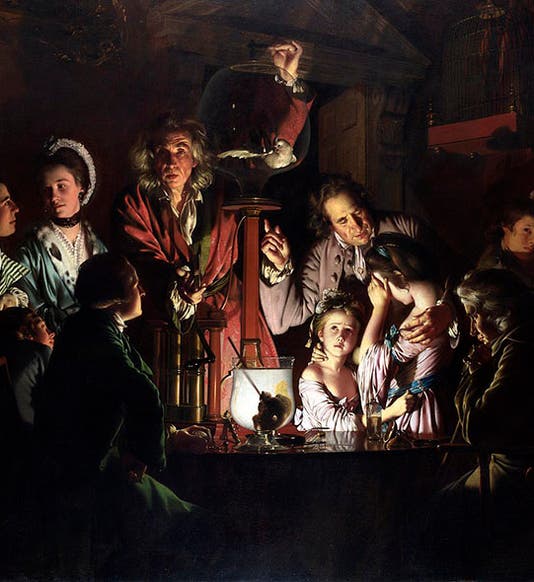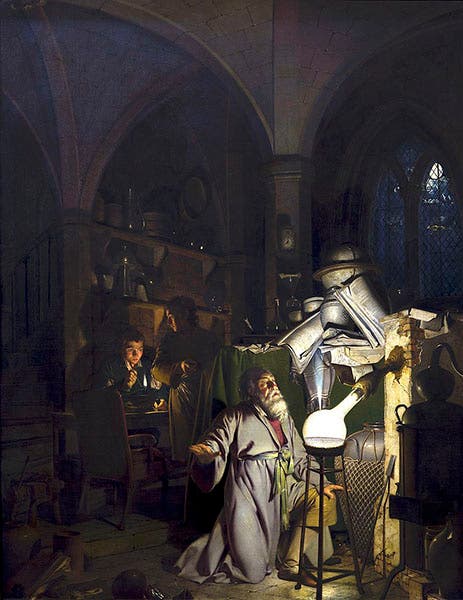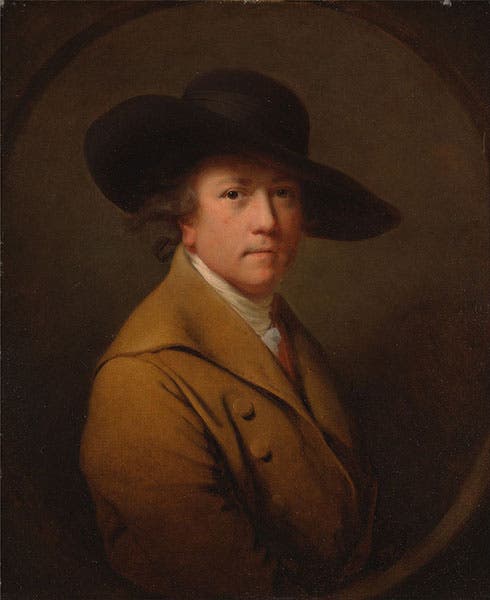Scientist of the Day - Joseph Wright
Joseph Wright, an English painter, was born Sep. 3, 1734. Usually known as Joseph Wright of Derby, he was one of very few 18th-century British artists to take an interest in natural philosophy, and to make science a focus in his paintings. Three of his paintings are especially notable as dealing with scientific subjects. The first is An Experiment on a Bird in an Air Pump (1768), in the National Gallery in London (first image). It shows a Newton-like figure in the process of evacuating the air from a glass vessel, using a mechanical air pump. There is a bird in the vessel who is going to teach the onlookers about the importance of air in our diet. The viewers apparently know what is going to happen, as their faces reflect varying degrees of dismay and horror, especially the two young girls in the foreground. A striking feature of this painting is that all of the light comes from an unseen source behind the glass bowl on the table, producing strong patterns of light and shadow on the faces of the onlookers. This fascination with chiaroscuro effects is typical of many of Wright's paintings.
Another well-known Wright painting with a scientific theme is A Philosopher Lecturing on an Orrery (1766), in the Derby Museum and Art Gallery. Here the central element is a mechanical model of the solar system, called an orrery, and in this case all the light in the painting is provided by a lamp that has replaced the Sun in the model. The entire scene is carved from light and shadow.
A third Wright painting is called The Alchemist Discovering Phosphorus (1771) and is also in the Derby Museum (second image). It is thought to portray a moment when Hennig Brandt discovered the element phosphorus by boiling down urine in 1669. Phosphorus in the presence of air will glow, or phosphoresce, and the glowing phosphorus provides all the light in the painting. This painting can be read many ways – it seems to be as much a religious painting as a scientific one. But the chiaroscuro effect is again notable, especially in the light patterns on the globe and vessels that sit above the flask. The white light of the phosphorus is nicely contrasted with the yellow candlelight highlighting the two assistants at the left. The original of this image on Wikimedia commons is high resolution; if you go to it and click on the image, you will be rewarded with a greatly enlarged image that you can browse through. I encourage you to pause on the Alchemist’s face – it is an extraordinary feat of portraiture.
Wright also painted landscapes, some of which seem to protrude into the province of natural history. For example, he took a trip to Italy in 1774 and drew some of the islands, and also turned out quite a few paintings showing Mt. Vesuvius erupting, as seen from Portici. We link to the painting at the Huntington Art Gallery, which is especially dramatic. This would have more scientific force if Wright had observed an eruption of Vesuvius, which he did not. But he did have an uncanny way of making you think he had.
Wright’s status as painter of the sciences was reinforced by his membership in the Lunar Society, an informal gathering of scientists living in and around Birmingham, which included Erasmus Darwin, Matthew Boulton, Josiah Wedgwood, John Whitehurst, William Withering, and James Watt. Wright painted portraits of many of these colleagues; you can see two of them in our entries on Erasmus Darwin and Whitehurst.
Most of Wright’s paintings are in the Derby Museum and Art Gallery. He did several self-portraits. Our favorite is the one in the Yale Museum of British Art, which we reproduce just above, painted about 1780. There is another, showing him a little older, in the National Portrait Gallery in London. Both show a relatively young painter. And yet the three paintings we featured here were finished ten years earlier than the Yale self-portrait. His talent blossomed early.
Dr. William B. Ashworth, Jr., Consultant for the History of Science, Linda Hall Library and Associate Professor emeritus, Department of History, University of Missouri-Kansas City. Comments or corrections are welcome; please direct to ashworthw@umkc.edu.








